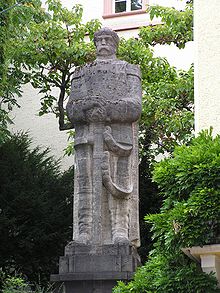Oskar Kiefer

Oskar Kiefer (actually Oskar Alexander Kiefer , born February 26, 1874 in Offenburg , † September 9, 1938 in Boulogne-sur-Mer ) was a German sculptor from the Baden town of Ettlingen . The anti-war memorial on the town hall tower in Ettlingen is one of his most famous works .
Life
Oskar Kiefer was the son of the Ettlingen city architect Alexander Kiefer. His grandfather Josef Kiefer became known in Ettlingen as the master mason who demolished the medieval Baden Gate in 1837.
Kiefer left the secondary school in Karlsruhe in 1889 , and his father then sent him to an apprenticeship with a local carpenter . It was here that Kiefer's creativity came to the fore for the first time, as he made numerous pieces of furniture in good shape and quite heavily carved. In the final exam at the trade school in 1891, he received a prize.
After his apprenticeship, he went on a journey according to the old custom , as was customary for a journeyman carpenter at the time . Less than a year later he received a letter from his father telling him to return home to begin his studies at the Karlsruhe School of Applied Arts. If not, "... I will no longer finance this course ..." . He then came back somewhat reluctantly and then attended the Grand Ducal Badische Kunstgewerbeschule for three years (from autumn 1892 to summer 1895) . It was here that his decision to sculpt was made .
For a year he worked as a modeller in Stuttgart.
On November 1, 1896, Kiefer was allowed to join the Grand Ducal Badische Akademie der Bildenden Künste due to his outstanding achievements , where he soon became a master student of Hermann Volz , who endeavored to increase the realism common in those years through idealization .
As a trainee , he also heard the lectures of the controversial but stimulating senior building officer Carl Schäfer at the Polytechnic in Karlsruhe.
From 1896 Kiefer began with the first portrait busts. His grandmother and a fatherly friend were his models. Although the first artistic attempts were still turned towards realism, the emerging Art Nouveau was already making itself felt.
After the " seizure of power " by the National Socialists , Kiefer, an avowed opponent of the war and the regime, had great difficulties in practicing his art.
Kiefer died in a boat accident in France .
Works
An important factor for his later life was the close friendship with the Swiss architect Karl Moser . Kiefer was able to create some sculptures on its buildings (in addition to sculptural facade design, for example at the Brauhaus Moninger and the Bankhaus Homburger in Karlsruhe), such as:
- the Luther Church (Karlsruhe) (Martin Luther sculpture)
- the Kunsthaus Zürich (relief above the portal)
- the Antoniuskirche in Basel
- the Pauluskirche (Bern) and other churches in Zug , Degersheim and Flawil
- of the New Nikolaikirche , Frankfurt am Main (relief on the pulpit altar from 1909)
- the Badischer Bahnhof in Basel (gable decoration)
- the "Roman Castle" in Baden
- of the city hall in Karlsruhe (sculptures)
Other sculptures:
- War memorial at Ettlingen Town Hall
- Plastic of Venus Kallipygos (Watthaldenpark Ettlingen)
- Bismarck Monument Baden-Baden (1915)
Honors
On April 9, 1975, the city of Ettlingen named a street after him after a resolution in the local council .
literature
- PH Stemmermann: Oskar A. Kiefer: A sculptor from Ettlingen, life and work. Extended Edition. 1988.
Web links
| personal data | |
|---|---|
| SURNAME | Kiefer, Oskar |
| ALTERNATIVE NAMES | Kiefer, Oskar Alexander |
| BRIEF DESCRIPTION | German sculptor |
| DATE OF BIRTH | February 26, 1874 |
| PLACE OF BIRTH | Offenburg |
| DATE OF DEATH | September 9, 1938 |
| Place of death | Boulogne-sur-Mer , France |


